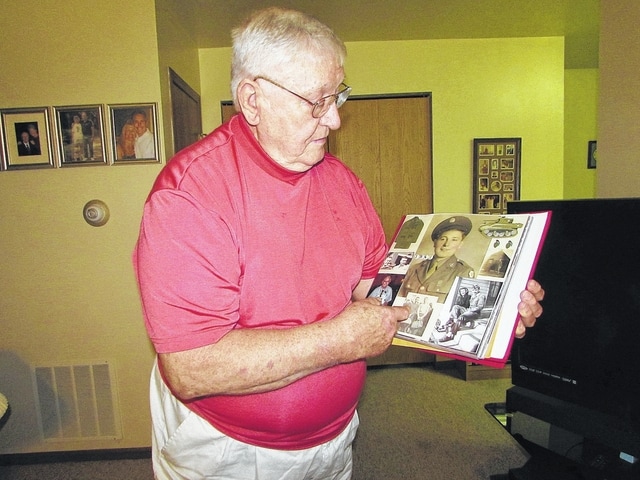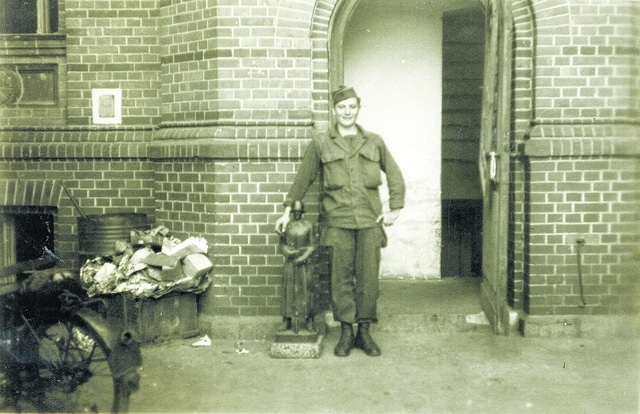



Editor’s note: This is one of a series of articles that will run until Labor Day in advance of the return to Sidney of the Vietnam Memorial replica wall and a Field of Valor featuring American flags in Custenborder Park. Both exhibits are by the Shelby County Historical Society. Flags for the Field of Valor can be purchased by calling 498-1653. The project commemorates 2015 as the 240th anniversary of the start of the Revolutionary War, the 150th anniversary of the end of the Civil War, the 70th anniversary of the end of World War II, the 65th anniversary of the start of the Korean War, the 40th anniversary of the end of the Vietnam War and the 20th anniversary of Desert Storm. The series will include stories about most of America’s wars. Today, a veteran shares his memories of World War II.
SIDNEY — When then President Harry Truman, Soviet leader Joseph Stalin and British Prime Minister Winston Churchill met in Potsdam, Germany, at the end of World War II to discuss German reparations and land divisions, Sidney resident Alga “Barney” Adams, now 90, was there.
Well, he wasn’t actually in the conference room with the world powers. But he wasn’t far away. He was just outside, driving a tour bus. Those leaders had arrived in Germany with entourages of some 4,000 people who wanted to see what Berlin looked like. The young Army private made daily trips to take them past the Brandenburg gate, the Reichstag offices, the Tiergarten, underneath which Hitler committed suicide, the site of the 1936 Olympics and the canal where the Russians were packing boats as fast as they could with looted German machinery.
Among the tiny photos on Adams’ worn scrapbook pages are some of the aged bus and one of Churchill striding down a German street.
Adams hadn’t planned to be at the site of one the world’s most historic conferences when he was drafted into the Army in late 1942. The 18-year-old had left Sidney High School and secretly married his teenage sweetheart, Reba Lehman. He left Sidney on a troop train — his first of many military train rides — April 1, 1943. He got as far as Columbus.
“They didn’t have enough uniforms, so we had to lay there a couple of days,” he said recently. “Because my name is A, I was first on KP in my civilian clothes.”
He completed basic training in Aberdeen, Maryland, and then trained to drive every type of vehicle the Army had on the ground, except a tank.
His first job was then to teach soldiers in the Women’s Army Corps how to drive 2 1/2-ton trucks, but he was soon transferred by troop train to Atlanta to learn how to repair tires.
“You had to learn all about rubber,” he said, “how to vulcanize tears shut, how to retread them.” He got on another troop train and traveled to California to teach a second company what he’d learned.
“We get to Bakersfield and they’ve changed their mind,” he said. Next destination: Pasadena’s Santa Anita Race Track.
The track had been used as an internment camp for Japanese-Americans. The Army took it over for training, and that’s where Adams went through basic training a second time to be ready to join a depot company.
“The purpose of the depot company was to store medical supplies, tank treads, small-arms parts, artillery parts,” he said. He got back on a train to Toledo.
“There was a big depot, warehousing in Maumee,” he said. There, he had to learn what each part was.
“I got a diploma from that place and went back to California,” he said. And from California, he shipped overseas — to Europe. The troop train that took him to Camp Kilmer, New Jersey, passed right through Sidney; but no one was permitted to leave the train at its various stops.
Adams boarded a ship on Christmas Day, 1943. It was part of a large convoy of troop ships, destroyers, supply ships and an aircraft carrier that slowly made its way across the Atlantic.
“One day, everything stopped,” he said. “There could be no smoking, no talking, no noise. It lasted an hour or two. There must have been a sub(marine) nearby. I never heard any charges or anything and I never learned why we stopped. Then we went on. We landed at Liverpool. We’d been on the water 12 days.”
The soldiers went from the ship right onto a train — this time, a British one — that took them to Honeybourne, barely a crossroads in the English countryside.
“Our camp was farmland. They’d put up a bunch of tents. The latrine was finished but the shower hadn’t been finished. There was no heat. You could take a cold shower if you wanted to, but it was January! Keep in mind that we hadn’t had a shower for 12 days. Well, you could have taken a salt water shower but you weren’t allowed to use fresh water (on the ship),” Adams said.
They made their own mattresses by stuffing bags with straw. The camp, called G24, was his home for the latter part of 1944.
“I went back to driving. I hauled parts in and out. Prior to D-Day, we started hauling stuff to the ports. By D-Day, we had nothing left in our warehouses,” he said. His unit was transferred to camp G25, where heavy artillery and vehicles were assembled.
“A 2 1/2-ton truck would arrive (as parts) in a box,” he said. It was there that he and his buddies watched all the planes that were part of the D-Day invasion fly right over them.
“We didn’t know what was going on,” he said.
His next move was to infantry training. He was billeted in barracks that were an ancient cavalry building. There were fireplaces at each end.
“The guys near the ends burned up. The guys in the middle froze to death,” Adams said. He and his company were training to replace soldiers in France and Belgium.
“You learned how to stay alive,” he said. He was shipped across the English Channel to France to a place known as Lucky Strike. After two weeks there, he boarded a 40 and 8 train (it could carry 40 men and eight horses) to Liege, Belgium, where he and one other soldier were put into what had been a Catholic church. They took turns sleeping and standing guard.
“‘What about meals?’ I asked. ‘You can eat K-rations and we’ll bring you one hot meal a day,’” he was told. The meal turned out to be breakfast, because it was easiest to make.
“I got sick of looking at pancakes,” Adams laughed.
It was from Liege that he moved into Germany. This time, he wasn’t on a train, but in an open truck.
“It was colder than the dickens. You zipped into a sleeping bag to keep warm,” he said. But when he arrived, his new digs had hot showers.
He was assigned to the 1st Allied Airborne division to drive a jeep.
“When the war was over, we moved to a Luftwaffe base in Halle, Germany, in the Russian district,” Adams remembered. Germany had been divided into sections under the administration of the various Allied countries who had won the war.
“That place was nice: private showers, nice beds,” he said. But the actual destination was Berlin. The company arrived in the dark of night and found a park in the middle of the city, where they pitched their tents. The next day, they were told to occupy an apartment building that was across the street from the park.
“If Germans don’t like it, throw them out,” their commanding officer said. Adams moved in with a German couple who had been living without electricity or water and they had no food.
“They were nice people. He was a World War I veteran, a chimney sweep. We fed them. We’d go through the chow line and eat. Then we’d go back for seconds and take it to them. They could live two or three days on one meal,” he said.
The soldiers cleaned a former German telephone factory to be the Berlin headquarters of the Allies. The Army had taken over the whole city block and threw out the Germans who had been living in houses and apartments there.
“Remember, we were the conquering army,” Adams said.
And it was from those headquarters that Adams took tourists through war-torn Berlin. Later, he became the personal driver of a radio-factory owner.
“I left Berlin on Thanksgiving, 1945, for Bremenhaven,” he said. And he boarded a ship for home on Christmas Day, two years to the day from when he had shipped out from the U.S.
After his discharge, he worked at several jobs in Sidney before he joined Monarch Machine Co., where he worked for 40 years, retiring as a superintendent in 1991.

